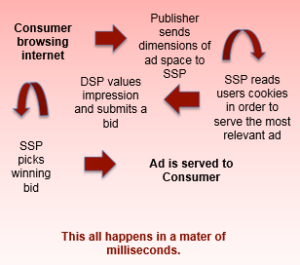An active profile on social media, active presence on the latest messenger app, and an e-mail ID as an address for communication – these traits are common to individuals as well as businesses in today’s world. We live in an era where information is easily accessible and abundantly available. Every source of information is now digitized to cope up with the growing demand. Every individual is now a subject expert, thanks to the arsenal of information available at their disposal. With digital platforms like websites, social networks, blogs, and mobile applications, creating and sharing content (information) is now quick and easy.
With growth in digital content, came a huge advertising opportunity which with the help of technology could generate billions in revenue. The initial phase where the digital properties were open as a platform for advertisers to advertise, adopted a traditional buyer-seller system. This system is called direct buying which is followed even today (though in diminishing rates). In this model, the advertiser reaches out directly to the publisher (content owner) and buys ad slots on the publisher’s property. This is generally done based on guaranteed number of impressions. The advertiser may buy a fixed road-block inventory or Run-On-Site (ROS) inventory. Here the pricing (generally CPM) is negotiated and fixed.
Spread across various categories, attracting various audience segments as visitors and generating more meaningful content, a rapid growth in the number of publishers was seen on the digital medium. With multiple publishers, limited budgets, and specific target audience it was now getting difficult for advertisers to buy the most-apt media. To overcome the challenges faced by advertisers and publishers, a new medium to buy media was introduced called the Ad Network(s). An ad network would have aggregated inventory from multiple publishers and packages based on ad units, audience category, and pricing models. Advertisers can buy inventory from multiple publishers through an ad network. Here the pricing is fixed by the ad network and the impressions are offered at a first-come-first-served basis.
The ever-evolving technology has played a very important role in building the way media is bought across networks. The most recent technology involved in media buying is programmatic advertising. From direct buying to buying media through ad networks, media buying has now reached a phase which is the promise of the future. Programmatic advertising is the future of Media Buying not just on digital but on television as well.
What is Programmatic Advertising?
“By 2019, global programmatic ad spend will reach USD 37 billion accounting for half of display and video expenditures.”
Remember the phase when a CPC pricing was introduced; this was treated as a golden opportunity by advertisers since they didn’t have to pay for every impression rather just for the clicks that happen on their ads. Programmatic should also be greeted in a similar way. It is part of the advancement made in the media buying industry.
Today’s media buying has adopted a different approach. With the quantum of data available, the granularity of targeting demanded, and the multiple options to keep the user engaged, it is humanly impossible to manually pick and choose the best advertising opportunities. So instead of manually managing advertising campaigns, you opt for machines to automatically do it for you. This helps advertisers to better concentrate on strategizing the campaign and not worry about the scale and reach. In other words, the computer is left to do what it does best, and so do you.
Programmatic media buying is not just about RTB (Real Time Bidding), it is not at all about remnant inventory, rather Programmatic Media Buying can be better explained as a booking mechanism build to sell inventory to advertisers directly or through exchanges. RTB is the key element with which programmatic advertising started off. Traditionally advertising opportunities were sold in blocks of 100 impressions without any specific targeting. All the users of the property (websites) saw the same ads. In programmatic, each advertiser can specify target audiences and show specific ads to only certain audience based on data (machine learnings). With programmatic advertising, interest based advertising aka contextual advertising has received some limelight. So programmatic can be understood as a technology that uses data and pushes the right ad to a specific user at the right time. This is executed over a private marketplace and can involve direct buying on RTB. This would enable advertisers to have more impactful ad campaigns.
How does programmatic advertising work?
For automating the paperwork involved, for setting up the campaign with precise targeting, for automatically buying and optimizing the media spend, and most importantly for helping the advertisers to focus on more important aspects, every advertiser would have his own list of reasons in favor of programmatic advertising. The shift from a traditional media buying to a programmatic media buying would never be an easy one, but once we shift advertising to an auto-pilot mode, the effectiveness is visible within a very short stint.
Programmatic media buying offers a win-win promise to all advertisers. The algorithms developed based on machine learning (audience behavior) clubbed with automation of processes, create a direct impact on the productivity of the entire marketing and advertising team. The programmatic system gathers audience behavior and based on the algorithm uses this data to serve best-targeted ads.
Programmatic media buying includes the use of DSPs, SSPs and DMPs. DSPs, (demand side platforms) which facilitate the process of buying ad inventory on the open market, provide the ability to reach your target audience due to the integration of DMPs (data management platforms). DMPs collect and analyze a substantial amount of cookie data to then allow the marketer to make more informed decisions of whom their target audience may be.
On the publisher side of things, publishers manage their unsold ad inventory through an SSP (supply side platform). An SSP reports attention data such as how long a visitor was on a specific site or how many pages were viewed per visit. SSPs will ultimately be in charge of picking the winning bid and will serve the winning banner ad on the publisher’s site.

The Big Revolution- being missed by few
Even though we have seen a growth in the share of ad budgets being assigned to programmatic, we are yet to see a similar growth rate in the number of marketing teams to adopt the programmatic approach. Media and entertainment industries have been the 2 biggest contributors to programmatic spend in the past. Some of the obvious reasons why we have many marketers yet to adopt programmatic would be as listed below.
- Would require the team structure to be changed?
- Lack of experience in understanding data
- Following the market trend
How can we get started
The best way is to get in touch with us. We will get you going right away.




What a good YouTube video it is! Awesome, I liked it, and I am sharing this YouTube film with all my mates.
http://autorazbor-ki.ru/forum/viewtopic.php?f=16&t=145205
http://db12.dissonant.ca/showthread.php?tid=548913
[url=http://old.ccia-arad.ro/forum2/showthread.php?tid=738669&pid=799021#pid799021]best online shooter game free[/url]
[url=http://www.dissidence-gaming.com/forum/viewtopic.php?pid=42636#p42636]online free shooter game[/url]
I used to be recommended this blog via my cousin. I am no longer sure whether this submit is written through him as no one else recognise such precise approximately my difficulty. You’re amazing! Thank you!
http://sl.3agel.net/42361
http://onceuponacrime.net/yourls/33979
[url=http://quegenial.es/80485]free online first person shooter[/url]
[url=https://atho.me/74141]free online shooting game[/url]
This blog is worth everyone’s attention. How can I find out more?
I must thank you for the efforts you’ve put in penning this blog. I’m hoping to see the same high-grade blog posts by you later on as well. In truth, your creative writing abilities has motivated me to get my own website now 😉
I am not sure where you are getting your info, but great topic. I needs to spend some time learning much more or understanding more. Thanks for fantastic information I was looking for this info for my mission. gkkcgekbaeeb
I just like the valuable info you provide in your articles. I will bookmark your weblog and check once more here frequently. I am moderately sure I will be told lots of new stuff right right here! Best of luck for the following! kkeebaeeedbf